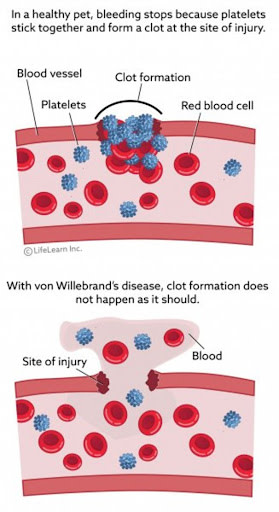Von Willebrand disease (vWD) is a common hereditary bleeding disorder characterized by a deficiency of the von Willebrand factor, a protein that’s needed to help the blood clot. Its symptoms can be dormant or difficult to spot and if left untreated, vWD can be life-threatening.
Unfortunately, because this condition is congenital, you can’t prevent your pet from developing it. However, you can learn more about the symptoms and treatment options to keep them safe and make sure they have a good quality of life.
Table of Contents
- What is von Willebrand disease in dogs?
- Which dog breeds are predisposed to canine von Willebrand disease?
- What are the different types of dog vWD?
- What are the signs and symptoms of vWD in dogs?
- How do you test for canine von Willebrand disease?
- Von Willebrand treatmeant for dogs
- Key Takeaways
Pro Tip: Hereditary conditions are inherited health conditions that can come in the later years of your dog's life. Pet insurance offers protection against such conditions, providing you with peace of mind should you face expensive vet bills due to a covered hereditary condition.
What is von Willebrand disease in dogs?
Von Willebrand disease, or vWD, is the most common hereditary blood clotting disorder in certain breeds of dogs.
If your dog’s blood isn’t able to clot, any injury they sustain can result in abnormal bleeding that is difficult to stop. The disease is caused by a deficiency or absence of a substance called the von Willebrand factor (vWF), which allows the platelets to stick together and form clots.
Many dogs with vWD don’t show any signs of it for several years, or until they sustain an injury that causes bleeding.
If left untreated, vWD can lead to excessive bleeding or even death.

(Image source: VCA Animal Hospitals)
Which dog breeds are predisposed to von Willebrand disease?
vWD is known to affect about 30 different dog breeds, but Doberman Pinschers have the highest incidence. According to VCA Animal Hospitals, a study that screened 15,000 Doberman Pinschers found that over 70% were carriers of the disease. The good news is that Dobermans usually have the mildest form of the disease.
The list of affected breeds also includes:
- German Shepherd
- Golden Retriever
- Shetland Sheepdog
- Manchester Terrier
- Scottish Terrier
- German Shorthaired Pointer
- German Wirehaired Pointer
- Standard Poodle
- Chesapeake Bay Retriever
- Welsh Corgi
- Akita
- Dutch Kooikerhondje
- Miniature Schnauzer
Types of von Willebrand disease in dogs
There are three different types of von Willebrand disease, based on whether the vWF is reduced or completely absent.
-
vWD Type 1: (Most common) All of the proteins that compose the vWF are present in dogs with vWD1, but not in sufficient quantity for effective clotting. Many pet parents are unaware that their dog has vWD1 until they experience an injury or undergo surgery. This form is typically seen in Doberman Pinschers, Standard Poodles, Shetland Sheepdogs, and German Shepherds.
-
vWD Type 2: Frequently seen in German Shorthaired Pointers and Wirehaired Pointers, this form of the disease occurs when the vWF is normal but the proteins are functionally or structurally defective. Dogs with type 2 von Willebrand disease can experience spontaneous bleeding episodes even if there is no trauma.
-
vWD Type 3: (Most severe) In this type of the disease, the von Willebrand factor is completely missing. This form is most commonly seen in Shetland Sheepdogs. Scottish Terriers, and Chesapeake Bay Retrievers.
What are the signs and symptoms of vWD in dogs?
Most dogs with vWD disease show no clinical signs and can go for years without the condition being discovered. Other dogs experience only mild symptoms that disappear over time as they age. However, in more severe cases, signs usually start to appear by the time the pup is one year old and can include:
- Bleeding from the nose, mouth, or gums
- Bloody, black, or tarry stools
- Prolonged bleeding after the loss of baby teeth
- Prolonged bleeding of small wounds
- Bruising of the skin
- Anemia from blood loss
- Blood in the urine
- Excessive bleeding during nail clipping
- Excessive vaginal bleeding during heat cycles
- Excessive bleeding during surgical procedures
How do you test for canine von Willebrand disease?
If you notice any of the above clinical signs, be sure to take your pet to the vet. There are tests that can help determine whether they have vWD, such as buccal mucosa bleeding time (BMBT), which can indicate prolonged bleeding. The diagnosis can be confirmed by determining the amount of von Willebrand factor in the blood through a laboratory blood test.
If you have a Doberman Pinscher, it’s recommended to have them tested for von Willebrand disease in case they need to undergo surgery. vWD testing is also suggested for other dog breeds that are genetically predisposed to blood clotting disorders.
If you plan to breed your dog, testing should be done beforehand — even if the animal doesn’t show symptoms. If the test indicates that your dog has von Willebrand disease or is a carrier, do not breed them with another dog that has the same status.

Treatment for von Willebrand disease in dogs
There’s no cure for vWD in dogs, but the disease can be managed.
Mild or moderate cases of canine vWD require minimal or no treatment to enjoy a good quality of life.
In emergency situations, dogs with von Willebrand disease can be given blood transfusions or frozen plasma to stabilize bleeding. Your veterinarian might also give the donor dog Desmopressin), a drug that helps raise the von Willebrand factor. DDAVP is given to dogs with vWD in non-emergency scenarios, but this drug is quite costly and not all dogs respond to it.
Dogs with vWD shouldn’t be given certain drugs that have anticoagulant or antiplatelet properties, including NSAIDs (including Aspirin and Carprofen), estrogen, Ibuprofen, antihistamines, antacid medications, penicillin, Amoxicillin/Ampicillin, Heparin, sulfa-based antibiotics, certain tranquilizers, etc.
Owners should also ensure that their pet avoids injuries as much as possible and stays away from hard foods like bones that could make cuts in the mouth or gum and cause bleeding.
Pro Tip: Some pet insurance providers cover hereditary conditions like von Willebrand disease, while others have coverage restrictions for certain conditions or require you to pay extra in order to add a rider for genetic condition coverage. For this reason, it’s very important to take some time to compare different pet insurance plans before choosing the best option for your dog.
Key Takeaways
- Von Willebrand disease is a blood disease caused by a deficiency of a protein called von Willebrand factor that is needed for blood to clot.
- This common hereditary disorder occurs more frequently in some breeds, including Doberman Pinschers, German Shepherds, Standard Poodles, Golden Retrievers, and Shetland Sheepdogs.
- Most dogs that lack the von Willebrand factor show no symptoms, but in more severe cases, symptoms such as nosebleeds and bloody stools may begin to appear by the time the dog is one year old.
- Most dogs with mild or moderate vWD often lead a decent quality of life, requiring minimal or no treatment. However, dogs with more severe forms of the disease will require blood transfusion before surgery.
- If your dog has vWD and has an episode of prolonged bleeding, be sure to take it to your vet or a veterinary clinic right away for emergency treatment.
